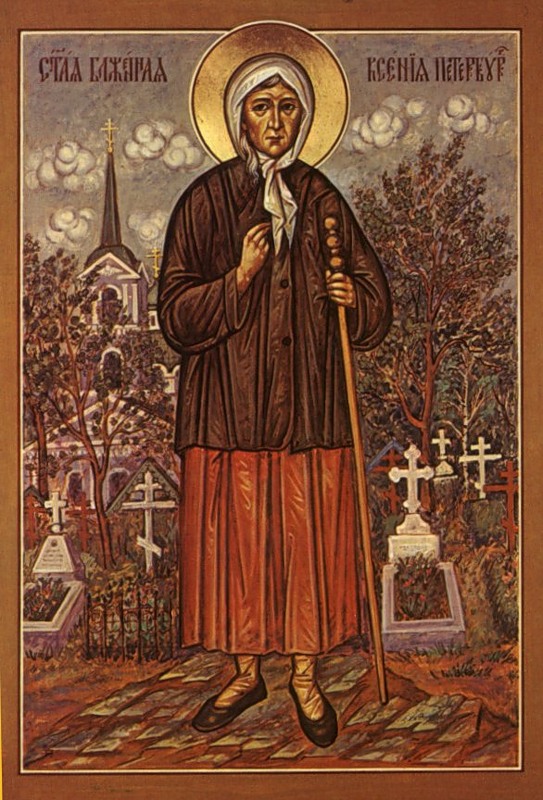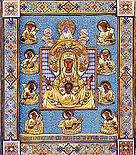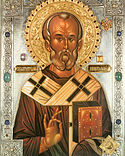St. Blessed Xenia and her Glorification by the ROCOR in 1978. How it all happened…

On February 6th n.s. the Russian Orthodox Church commemorates St. Blessed Xenia, the fool for Christ of St. Petersburg. At the beginning of the XXth century Blessed Xenia was a locally venerated blessed one, or fool for Christ of St. Petersburg, practically unknown outside of the city and the nearby villages. Her very interesting life was included in the 12-volume collection “Strugglers of Piety of the XVIII_XIX Centuries” compiled by the well-known Orthodox writer, E. Poselianin, but even this did nothing to spread her veneration much past St. Petersburg. How did this relatively obscure pious struggler of the age of Catherine the Great eventually become one of the best-known and most beloved Russian saints?
A very large, and perhaps even key role in this story was played by the Committee of St. Bl. Xenia, founded in the early 70’s by Nina Antonovna Siniavskaya. Many have forgotten or never knew the history of this committee and its founder, so on St. Xenia’s feastday I would like to remind everyone of this wonderful person, who did so much for the glorification of this saint. Nina Antonovna was the child of old Russian emmigrants and became a professor of Russian in the Slavic languages department of Columbia University in New York City. She never married, and one day she shared her sorrow and her fears that in her old age she would be forgotten and all alone. The famiy of Nina Antonovna’s friend happened to be from St. Petersburg and they venerated the memory of their local blessed one. Remembering how people would always go to pray at her grave and celebrate memorial services, especially when they had family or personal problems, or were praying for an Orthodox spouse. And she suggested that Nina Antonovna entrust her sorrows, problems and fears to this saintly woman. Even though she wasn’t much of a church-goer at this time, being an energetic and resourceful person, and a teacher besides, Nina Antonovna decided that that wasn’t enough, and soon set up the above-mentioned committee, so as to acquaint as many people as possible with Bl. Xenia. The committee soon published a biography of this blessed wanderer of St. Petersburg, ordered a portrait to be painted by Jordanville’s iconographer, Fr Kiprian (Pyzhov), printed out reproductions, and began to gather accounts of miracles worked by Bl. Xenia. Nina Antonovna began to make the rounds of ROCOR parishes, first throughout America, and later abroad as well, with talks and lectures about Bl. Xenia, collecting funds to expand this work. The committee decided to find out what had happened to Bl. Xenia’s grave. And the chapel that had stood over it at the Smolensk cemetery in the city that was by then Leningrad. Committee members began to visit the grave regularly, which in those Cold War years was a complicated and not entirely safe enterprise. The grave was surrounded by a wooden fence through which the rundown chapel could be seen. The Orthodox faithful of Leningrad hadn’t forgotten their intercessor, and people constantly stuck notes into the fence, with prayers to and pleas for help from Bl. Xenia, which of course greatly annoyed the godless authorities. The committee began to hand out and leave brochures and portrait prints near the chapel, and interest in this place suddenly began to grow quite quickly, both among the local faithful and throughout the Russian diaspora. There were persistent rumors that the Leningrad city administration was planning to tear down the chapel, destroy the grave, and set up a huge bust of Lenin on its place. Soon every parishioner of ROCOR that happened to be in Leningrad for business, studies, or on a tour felt duty-bound to make a visit to Bl. Xenia’s chapel. Though the chapel was only finally reopened in time for Bl. Xenia’s glorification by the MP in 1988, I believe that the committee’s constant visits and the resultant constantly growing interest in this holy site did much to preserve the chapel from desecration and destruction. Thanks to the efforts of Nina Antonovna’s committee the popularity and veneration of Bl. Xenia spread quickly throughout the Church Abroad. The committee itself kept expanding and hundreds of miracles were recorded; so many, that very soon they had a well-prepared case and request for a church-wide glorification to present to the Synod. The next Sobor of the Church resolved to proceed, and blessed the committee to begin preparations. At this point Nina Antonovna really came into her own as an extremely efficient manager and organizer. By the time of the glorification a service to the Blessed one was composed, translated into English, both texts were published and ready for sale and distribution. A large icon for the glorification itself was ordered, and many smaller ones, so as to be readily available to parishes and individuals., и много киотных икон, для храмов и домов, напечатаны репродукции всяких размеров. Reproductions of the icons in all sizes were printed up. A huge hall was rented for a festive banquet to complete the festivities, lecturers and those that wanted to share their stories of Bl. Xenia’s miraculous intercession were organized. A film crew was set up. The glorification itself was a truly spiritual feast and taste of paradise. By the All-Night Vigil over two thousand faithful had gathered. The service was chanted by two choirs, in Slavonic and English, in a cathedral filled to over-flowing. Many thought that after the glorification the work of the committee would be finished, but Nina Antonovna quickly reorganized it into a charitable fund. She began to travel throughout the Russian diaspora, showing the film of the glorification, and collecting funds for charitable work. For many years the Blessed Xenia Fund supported a small clinic for sick and elderly nuns at the Mount of Olives monastery in the Holy Land, and helped other ROCOR monasteries, as well as needy clergy and many other sick and suffering people. Love and veneration for St. Bl. Xenia continued to grow, both in Russia and abroad. In 1988 the MP glorified her amongst the saints as well. St. Xenia became known and beloved in many other countries and Orthodox churches, and to this day there are unceasing pilgrimages to her grave and chapel. In conclusion I need to add that Nina Antonovna never did marry, but St. Bl. Xenia herself filled her life to such an extent and brought her so many friends, that she never knew the loneliness that she had once so feared. She remains a great example to me of how much a simple layperson can do in the Church if they have a sincere desire and the resolve. Memory eternal to the handmaiden of God Nina, the most faithful and dedicated of st. Xenia’s spiritual children.
Glorification: https://www.youtube.com/watch?v=CiQUkH9N0v0

